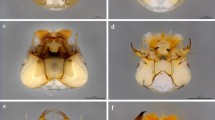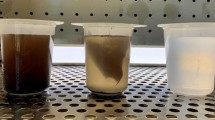Summary
The insect fauna of water-filled tree holes in southern Britain consists primarily of the mosquitoes Aedes geniculatus, Anopheles plumbeus, Culex torrentium, and a benthic detritivorous fauna that includes primarily the scirtid beetle Prionocyphon serricornis and the chironomid midge Metriocnemus martinii. Culex torrentium has been documented only relatively recently in tree holes but all three species of mosquitoes partition the resource in space and time. When mosquito larvae were forced to coexist in natural tree holes at limiting densities and at higher than natural levels of interspecific encounter, there was no evidence that Aedes geniculatus or Anopheles plumbeus affected pupation success, pupal weight, or development time of the other or that either Aedes geniculatus or C. torrentium affected the survivorship, pupation success, pupal weight, and biomass yield of the other. When A. geniculatus at limiting densities were forced in natural tree holes to live without or to coexist with natural or twice natural densities of P. serricornis and M. martinii, the presence, absence, or superabundance of the benthic insects did not affect pupation success or pupal weight of A. geniculatus; development time of A. geniculatus was faster when a superabundance of the benthic fauna was present. Effects of the benthic fauna on A. geniculatus are slight and the only significant interaction is facilitative, not competitive. The pattern of habitat segregation among treehole mosquitoes in southern Britain is characteristic of their respective genera and we propose that this pattern is more likely (but not certain) to have arisen through a process of independent evolution than through competitively driven niche shifts among already coexisting species.
Similar content being viewed by others
References
Atkinson WD, Shorrocks B (1984) Aggregation of larval Diptera over discrete and ephemeral breeding sites: The implications for coexistence. Am Nat 124:336–351
Beattie MF, Howland LJ (1929) The bionomics of some tree-hole mosquitos. Bull Entomol Res 20:45–58
Beaver RA (1977) Non-equilibrium “island” communities: Diptera breeding in dead snails. J Anim Ecol 46:783–798
Blacklock B, Carter HF (1920) Observations on Anopheles (Coelodiazesis) plumbeus, Stephens, with special reference to its breeding places, occurrence in the Liverpool district, and possible connection with the spread of malaria. Ann Trop Med Parasit 13:421–444
Bradshaw WE (1983) Estimating biomass of mosquito populations. Environ Entomol 12:779–781
Bradshaw WE, Holzapfel CM (1983) Predator-mediated, nonequilibrium coexistence of tree-hole mosquitoes in southeastern North America. Oecologia 57:239–256
Bradshaw WE, Holzapfel CM (1984) Seasonal development of tree-hole mosquitoes (Diptera: Culicidae) and chaoborids in relation to weather and predation. J Med Entomol 21:66–78
Bradshaw WE, Holzapfel CM (1985) The distribution and abundance of treehole mosquitoes in eastern North America: Perspectives from north Florida. In: Lounibos LP, Rey JR, Frank JH (eds) Ecology of Mosquitoes: Proceedings of a Workshop. Florida Medical Entomology Laboratory, Vero Beach, pp 3–23
Bradshaw WE, Holzapfel CM (1986) Habitat segregation among European tree-hole mosquitoes. Nat Geogr Res 2:167–178
Bradshaw WE, Holzapfel CM (1988) Drought and the organization of tree-hole mosquito communities. Oecologia 74:507–514
Bradshaw WE, Holzapfel CM (1991) Fitness and habitat segregation of British tree-hole mosquitoes. Ecol Entomol 16:133–144
Cody ML (1968) On the methods of resource division in grassland bird communities. Am Nat 102:107–147
Cody ML, Diamond JM (eds) (1975) Ecology and evolution of communities. The Belknap Press of Harvard University Press, Cambridge
Connell JH (1983) On the prevalence and relative importance of interspecific competition: Evidence from field experiments. Am Nat 122:661–696
Copeland RS (1987) Habitat segregation and life history patterns of the Culicidae of treeholes in northern Indiana. Doctoral Thesis, University of Notre Dame, Notre Dame
Copeland RS, Craig GB (1990a) Winter cold influences the spatial and age distributions of the North American treehole mosquito Anopheles barberi. Oecologia 79:287–292
Copeland RS, Craig GB (1990b) Habitat segregation among tree-hole mosquitoes (Diptera: Culicidae) in the Great Lakes region of the United States. Ann Entomol Soc Am 83:1063–1073
Diamond JM (1978) Niche shift and the rediscovery of interspecific competition. Am Sci 66:322–331
Fallis SP, Snow KR (1983) Larval development in Orthopodomyia pulchripalpis (Rondany) (Diptera; Culicidae). Entomol Month Mag 119:75–79
Fisher IJ, Bradshaw WE, Kammeyer C (1990) Fitness and its correlates assessed by intra- and interspecific interactions among tree-hole mosquitoes. J Anim Ecol 59:819–829
Hard JJ, Bradshaw WE, Malarkey DJ (1989) Resource- and density-dependent development in tree-hole mosquitoes. Oikos 54:137–144
Hawley WA (1985a) Population dynamics of Aedes sierrensis. In: Lounibos LP, Rey JR, Frank JH (eds) Ecology of mosquitoes: Proceedings of a workshop. Florida Medical Entomology Laboratory, Vero Beach, pp 167–184
Hawley WA (1985b) A high-fecundity Aedine: Factors affecting egg production of the western treehole mosquito, Aedes sierrensis (Diptera: Culicidae). J Med Entomol 22:220–225
Holter P (1982) Resource utilization and local coexistence in a guild of scarabaeid dung beetles (Aphodius spp.). Oikos 39:213–227
Hurlbert SH (1978) The measurement of niche overlap and some relatives. Ecology 59:67–77
Hutchinson GE (1959) Homage to Santa Rosalia, or why are there so many kinds of animals? Am Nat 93:145–159
Keilin D (1927) Fauna of a horse-chestnut tree (Aesculus hippocastanum). Dipterous larvae and their parasites. Parasitology 19:368–374
Kitching RL (1971) An ecological study of water-filled tree-holes and their position in the woodland ecosystem. J Anim Ecol 40:281–302
Livdahl TP (1982) Competition within and between hatching cohorts of a treehole mosquito. Ecology 63:1751–1760
Lloyd M (1967) “Mean crowding”. J Anim Ecol 36:1–30
Lounibos LP (1981) Habitat segregation among African treehole mosquitoes. Ecol Entom 6:129–154
Lounibos LP (1983) The mosquito community of treeholes in subtropical Florida. In: Frank JH, Lounibos LP (eds) Phytotelmata: Terrestrial plants as hosts for aquatic insect communities. Plexus, Medford, pp 223–246
Lounibos LP (1985) Interactions influencing production of treehole mosquitoes in south Florida. In: Lounibos LP, Rey JR, Frank JH (eds) Ecology of mosquitoes: Proceedings of a workshop. Florida Medical Entomology Laboratory, Vero Beach, pp 65–77
Lu PL, Li BS, Xu RM, Jiang YY (1980) The composition of tree-hole breeding mosquitoes in the mountain forests of Diaolou, Hainan Island (Diptera: Culicidae). Bull Acad Military Med Sci (Peking) 1980(1):55–59
Macan TT, Tutin TG (1932) A note on rot-holes in horse-chestnut trees. Parasitology 24:283
MacArthur RH, Levins R (1967) The limiting similarity, convergence, and divergence of coexisting species. Am Nat 101:377–385
Marshall JF (1938) The British mosquitoes. British Museum of Natural History, London
Mattingly PF (1951) Culex (Culex) torrentium Martini, a mosquito new to Great Britain. Nature 168:172
Onyeka JOA (1980) Studies on the ecology and biology of Culex pipiens L. and Culex torrentium Martini (Diptera: Culicidae) in Britain. Doctoral Thesis, University of London, (Imperial College of Science and Technology, Silwood Park), Ascot
Rathcke BJ (1976) Competition and coexistence within a guild of herbivorous insects. Ecology 57:76–87
Rioux JA (1958) Les Culicides du ≪Midi≫ Méditerranéen-Étude systématique et écologique. Edition Paul Lechevalier, Paris, France
Rohnert U (1950) Wasserfüllte Baumhöhlen und ihre Besiedlung. Ein Beitrag zur Fauna Dendrolimnetica. Arch Hydrobiol 44:472–516
SAS Institute (1985) SAS user's guide: Statistics, version 5 edition. SAS Institute Inc., Cary
Schoener TW (1974) Resource partitioning in ecological communities. Science 185:27–39
Schoener TW (1983) Field experiments on interspecific competition. Am Nat 122:240–285
Seifert RP (1982) Neotropical Heliconia insect communities. Q Rev Biol 57:1–28
Service MW (1968) The taxonomy and biology of two sympatric sibling species of Culex, C. pipiens and C. torrentium (Diptera, Culicidae). J Zool Lond 156:313–323
Shroyer DA, Craig GB (1981) Seasonal variation in sex ratio of Aedes triseriatus (Diptera: Culicidae) and its dependence on egg hatching behavior. Environ Entomol 10:147–152
Sih A, Crowley P, McPeek M, Petranka J, Strohmeier K (1985) Predation, competition, and prey communities: A review of field experiments. Annu Rev Ecol Syst 16:269–311
Sokal RR, Rohlf FJ (1969) Biometry. W.H. Freeman and Company, San Francisco
Strong DR (1982) Harmonious coexistence of hispine beetles on Heliconia in experimental and natural communities. Ecology 63:1039–1049
Yates MG (1979) The biology of the tree-hole breeding mosquito Aedes geniculatus (Olivier) (Diptera: Culicidae) in southern England. Bull Entomol Res 69:611–628
Zavortink TJ (1970) Mosquito studies (Diptera, Culicidae) XIX. The treehole Anopheles of the New World. Contrib Am Entomol Inst 5:1–35
Zavortink TJ (1985) Observations on the ecology of treeholes and treehole mosquitoes in the Southwestern United States. In: Lounibos LP, Rey JR, Frank JH (eds) Ecology of mosquitoes: Proceedings of a workshop. Florida Medical Entomology Laboratory, Vero Beach, pp 473–487
Author information
Authors and Affiliations
Rights and permissions
About this article
Cite this article
Bradshaw, M.E., Holzapfel, C.M. Resource limitation, habitat segregation, and species interactions of british tree-hole mosquitoes in nature. Oecologia 90, 227–237 (1992). https://doi.org/10.1007/BF00317180
Received:
Accepted:
Issue Date:
DOI: https://doi.org/10.1007/BF00317180




